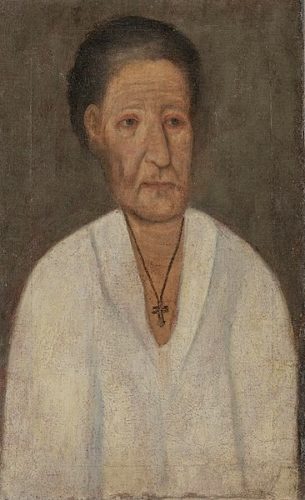Last Updated on February 6, 2025 by Kittredge Cherry

Xenia of Saint Petersburg is a 18th-century saint who married a soldier and assumed his identity after he died, becoming a “holy fool” who was canonized by the Russian Orthodox Church. This queer saint’s feast days are Jan. 24 and Feb. 6.
Xenia (c. 1719-1730 – c. 1803) was widowed at age 26 by the death of her husband, an army colonel named Andrei Fyodorovich Petrov. The childless saint-to-be showed up at the funeral in the husband’s military uniform, insisting on being called by his name and claiming that Xenia, not Andrei, had died.
Experiencing a spiritual rebirth, the female-to-male saint gave away the family fortune to the poor and lived free of worldly possessions as an ascetic “fool for Christ.” Known as Andrei for 45 years until death at age 71, the saint never responded to the name Xenia again. During that time, Andrei wandered the streets of St. Petersburg, helping the poor, healing the sick, prophesying the future and wearing the male military uniform until it turned to rags. Andrei faced much ridicule for rejecting social norms, but also had supporters. He lived in St. Petersburg’s Smolensk Cemetery, where the Chapel of Saint Xenia now marks the saint’s grave. Many miracles have been attributed to this queer saint.
This saint is well known in Russia and venerated as the “holy woman” Xenia of St. Petersburg (Ксения Петербургская in Russian), patron saint of that city. Xenia / Andrei is also the patron saint of people seeking a spouse, a job or a home. About 40 churches and chapels have been built around the world in Xenia’s name, including in Donetsk, Ukraine. The saint’s adopted name of Andrei is rarely used, although gender transition is an important part of every hagiography of Xenia. The saint’s story is also told in a major historical novel, “The Mirrored World” by Debra Dean.
Xenia is considered a holy fool or yurodivyy (юродивый), a role that is especially honored in Eastern Orthodox spirituality and in Russian literature by Fyodor Dostoevsky and others. Holy fools hide their radical devotion to God by deliberately breaking social norms with eccentric behavior while inwardly pursuing religious ideals or mystical experience. The term comes from the Apostle Paul of Tarsus, who wrote, “The wisdom of this world is foolishness in God’s sight” and “We are fools for Christ’s sake, but ye are wise in Christ” (I Corinthians 3:19 and 4:10). Another queer holy fool is Symeon of Emesa, a sixth-century Syrian ascetic who was joined in a same-sex union with John of Edessa.
Xenia / Andrei inspires LGBTQ people
Historical figures don’t fit neatly into contemporary LGBTQIA+ categories because they lived in another time and culture with different understandings of gender and sexuality. But Xenia / Andrei is an inspiration for today’s transgender people, if not necessarily a transgender saint. Arguments can also be made for Xenia to be classified as butch lesbian, gender nonconforming, third gender, genderqueer, nonbinary and the like.

“St. Xenia/Andrei: Pray for (r)US(sia)” by Jan Haen is included in his 2023 graphic non-fiction book “Heavenly LGBTQ+: Queer Icons from LGBTQ Life, Religion, and History” by Jan Haen, a Dutch artist and Roman Catholic priest. It is the sequel to his 2022 book “Heavenly Homos.”
Like many queer saints, Xenia / Andrei is hiding in plain sight, famous for changing gender, and yet strangely the LGBTQ implications are generally ignored. One exception is an article in the February 2020 issue of “TSQ: Transgender Studies Quarterly.” “Xenia the Servant of God, or Andrey Fyodorovich the Holy Fool,” by Nick Mayhew. It presents his translation of an 1890 hagiography by Dmitry Bulgakovsky. Mayhew describes it as “one of the first full accounts of the life of a saint variably referred to by two names: one feminine, Xenia, and one masculine, Andrey.” Mayhew, who teaches Slavic languages and literature at Stanford, is currently working on his first book, “Queer Traditions in Early Modern Russia.”
Xenia’s transformation into Andrei is unusual, but there are other queer saints with similar paths. The sudden insistence that their previously female self died is shared by a queer Quaker preacher in colonial America. Jemima Wilkinson woke from a near-death experience in 1776 with the sense of being neither male nor female. Adopting the name “Publick Universal Friend,” this fascinating nonbinary American fought for gender equality and founded an important religious community.

“St. Andrei (Xenia), Day of Remembrance – January 24” by the nonbinary group Snow Initiative (Инициатива СНеГ), based in St. Petersburg, Russia.
Xenia / Andrei also has a lot in common with cross-dressing monks who are being reclaimed as possible transgender saints. More than 20 saints share a similar story: They escaped their lives as women by dressing as men to join monasteries or live as desert hermits. Their hagiographies usually report that their biological sex was not discovered until their death. Xenia / Andrei breaks the pattern by being an urban saint who stayed in the same city even after claiming a male identity.
Icons try to feminize Xenia / Andrei
Accounts of the saint’s life clearly state that Xenia gave up ALL female clothing and as Andrei wore only the husband’s clothing. That includes his underwear, caftan tunic and camisole jacket / waistcoat.
Traditional icon of Saint Xenia was available on Amazon.
However artists feminized the saint in traditional icons, which usually show the saint wearing a red and green military jacket over a dress.
One exception is a portrait discovered in 1930 but apparently painted in the late 1700s to early 1800s, during or soon after the saint’s lifetime. Created long before the saint’s canonization in 1988 by the Russian Orthodox Church, it shows an androgynous Andrei in a simple white shirt. When experts restored the painting, they removed later overpainting that had added long hair in an effort to make the saint fit female stereotypes. Now Andrei’s original short haircut has been restored. The portrait is housed in the collection of the State Hermitage Museum in St. Petersburg.
Prayers: “Rejoice, for you renounced your own name”
Traditional Orthodox prayers to Saint Xenia include text that is ripe for reclamation by transgender people of faith. These lines seem to belong in a transgender re-naming ceremony, but they come directly from an Orthodox hymn known as the Akathist to Xenia of St. Petersburg. Unfortunately the sexist concept of “woman’s weakness” is expressed here and in much of the traditional writing about Andrei’s rejection of his previous female identity:
Rejoice, for you renounced your own name, referring to yourself as dead!
Rejoice, for you assumed foolishness and took the name of your husband, Andrei!
Rejoice, for you called yourself by a man’s name, renouncing woman’s weakness!
… Rejoice, for you were full of wisdom transcending the world!
Rejoice, for you preferred mockery and ridicule to earthly glory!
Rejoice, for you have been glorified by God!
Rejoice speedy helper in times of trouble and despair!
Rejoice, O blessed Xenia, who ever intercedes for our souls!
The traditional prayer also builds on another concept of importance to LGBTQ people: the sense of being a stranger or outcast in society. The name Xenia is often translated as “stranger.” Mainstream churches use this saint’s life to illustrate how Christians are called to be in the world but not of the world (John 17), resisting conformity to worldly society (Romans 12:2), living as “a stranger in a strange land” (Exodus 2:22) and finding a way to “sing God’s song in a foreign land.” (Psalm 137:4).
LGBTQ people, often rejected by church and society, may identify with the outsider experience that is expressed in the closing lines from the same Akathist to Xenia of St. Petersburg — and draw inspiration from the final promise:
A wandering stranger on earth, ever sighing for the heavenly homeland,
you were considered a fool by the senseless and unbelieving,
but were known to be wise and holy by the faithful.
God crowned you with glory and honor, O Xenia,
strong minded and divinely wise.
Therefore, we cry to you: Rejoice, for after earthly wandering
you have come to dwell in *God’s house.
*Inclusified from the original text “the Father’s house.”
___
Related links:
St. Petersburg Hermitage Museum displays only lifetime portrait of St. Xenia (OrthoChristian.com)
Pavel Florensky and Sergei Troitsky: Russian theologian of same-sex love and his soulmate (Q Spirit)
Boris and George: Russian saints united in love and death (Q Spirit)
Молитва Радужному Христу (Rainbow Christ Prayer in Russian)
___
Top image credit:
Portrait of Xenia of St. Petersburg, late 18th to early 19th century (Wikimedia Commons)
___
This post is part of the LGBTQ Saints series by Kittredge Cherry. Traditional and alternative saints, people in the Bible, LGBT and queer martyrs, authors, theologians, religious leaders, artists, deities and other figures of special interest to lesbian, gay, bisexual and transgender and queer (LGBTQ) people and our allies are covered.
This article was originally published on Q Spirit on March 1, 2022, was expanded with new material over time, and was most recently updated on Feb. 6, 2025.
Copyright © Kittredge Cherry. All rights reserved.
Qspirit.net presents the Jesus in Love Blog on LGBTQ spirituality.






















You are spreading misinformation! Saint Xenia was not transgender or queer or whatever else you’re falsely claiming here. She is an Orthodox Christian saint from the 18th century! What in the world are you even talking about? While a lot of the information above is factual, you are incorrect about that. The very first comment hit the nail on the head, you are making wild assumptions and presenting them as fact. You are disrespecting Saint Xenia.
I am having some trouble reconciling this interpretation of St. Xenia’s life with a) what I know about 18th-century Russia and b) what I know about the юродивый tradition. First, from a theological perspective, Xenia’s adoption of her husband’s “identity” was not about his gender. The point was that she was choosing to “be as one dead” something that is not only made clear from the hymns and hagiography but also from the accounts of other people essentially doing this same thing ie adopting the identity of a dead person as part of their ascetic renunciation. This was a particularly common thing for “fools for Christ” to do. This adoption of a dead person’s name etc had very little to do with gender from what I can tell from the sources.
Secondly, I think reading Xenia as trans in some way erases the sexism at work in this and other hagiographic stories. “Like a man” is a positive appellation applied from ancient times to female saints. And erasing traces of female-ness (including ceasing to menstruate is taken as a sign of holiness–cf. women who never menstruate are never kept by menstruation from taking the Eucharist). Female saints adopt male personas because maleness is seen as more holy (not to mention it is much safer to be perceived as male when traveling alone etc both then and now). I get the impulse to queer saints and other historical figures, but I think this kind of revisionism is ultimately harmful because it erases things like those mentioned above (among other reasons).
Remember: To this day, baby girls are not taken into the altar at their baptism because one day in the future they will menstruate. That’s still a thing.
I want to incorporate some of your ideas into the body of this blog article and some others, but that will take some time. You provided some valuable context. Even if Xenia’s transformation into Andrei had little to do with gender in the saint’s own mind, that in itself is significant for our own time, when gender is considered so important and clearly defined. I didn’t know that baby girls are not baptised at the altar. Which churches still follow that restriction?
Responding to Kittredge Cherry: Every Orthodox Church I know of (you might get a rogue priest here and there who will). I think also Copts and Oriental Christians, but I would have to check that one. For the record I was at a baptism in a Greek church two weeks ago for a boy and girl twins. The boy was taken into the altar. His sister was not. This is a parish that is considered quite progressive.
I wanted to share this story with a doctor friend, who is an active physician within a LGBT clinic. However there was no link to share with standard E-MAIL. I am opposed to FB & Twitter as honorable websites. thank you
Richard, I will work on setting up a way to share by email. I’m glad you like my article on St Xenia / Andrei so much that you want to share it, and I agree that Facebook and Twitter can be problematic. I used to have a share-by-email service, but they started inserting tons of ads into the emails, so I stopped using it and have not yet found a replacement. But you are motivating me to find a new email service right away. I’ll comment again when I have it set up. Thank you!
This article itself says “historical figures don’t fit neatly into contemporary LGBTQIA+ categories” but then tries to categorize Xenia of St. Petersburg into those categories anyway. Replacing her husband is certainly unusual but unlikely to have anything to do with LGBTQIA issues because it involves adopting someone else’s persona.